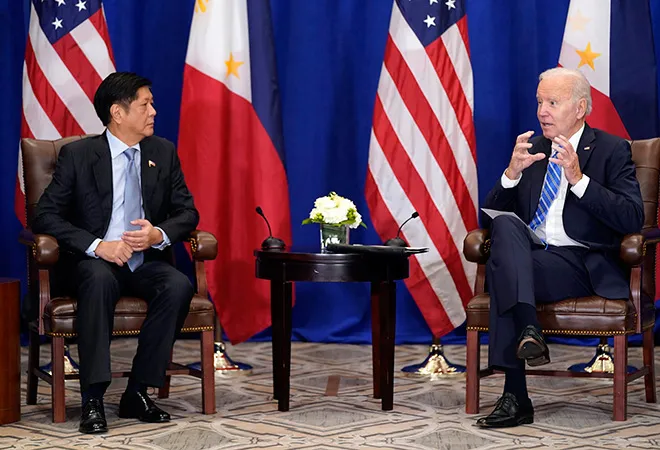-
CENTRES
Progammes & Centres
Location
As the China challenge grows in the Pacific, the US looks to tether its Pacific strategy around the Philippines by strengthening their security ties

One of the most predictable domains for crystal-gazing China’s belligerent state behaviour is the South China Sea (SCS). More so now, as growing Chinese state power and influence coincide with its global aspirations of gaining a competitive edge over the United States (US). The multiple conflicts that China has with the countries in the SCS have, in many ways, become a testing ground for not just ascertaining its own military power and preparedness in the Pacific theatre but also a tool for appraising the politico-security resolve of successive US governments. As the Biden administration in the US seems determined to strengthen its approach towards restoring America’s Pacific balance, China seems to be working methodically on a deadline towards a hostile takeover of Taiwan while simultaneously increasing bellicosity in its activities in the SCS and beyond.
The multiple conflicts that China has with the countries in the SCS have, in many ways, become a testing ground for not just ascertaining its own military power and preparedness in the Pacific theatre but also a tool for appraising the politico-security resolve of successive US governments.
The latest incident involved dangerous and unsafe manoeuvres by Chinese ships, which fired water cannons at the Philippine Coast Guard (PCG) ships that were carrying supplies for Filipino soldiers stationed at the Second Thomas Shoal (also known as Ayungin Shoal in the Philippines) in the Spratly Island. In June this year, Chinese ships attempted to prevent two PCG vessels from approaching the Second Thomas Shoal while escorting two wooden resupply boats. Similar incidents happened in February and July this year. At the heart of this conflict is a Filipino ship, BRP Sierra Madre (LT-57), which ran aground on 9 May 1997. Ever since, the Philippines has used the ship as a sovereign outpost by stationing eight soldiers on board to keep China in check. China claims the waters and wants the ship removed. Philippine President, Ferdinand Marcos Jr, stated that the Philippines will not withdraw or “pull out a World War II-era ship from the Ayungin shoal in the South China Sea.” A similar statement came from the National Security Council spokesperson Jonathan Malaya that, “China's increased presence at the Second Thomas Shoal will not deter the Philippines’ resolve to protect its position there”. He added that “the Philippines will not give up the Ayungin Shoal or remove the warship from the atoll which was intentionally grounded in 1999 to reinforce the Philippines' sovereignty claims.”
In the joint statement released by the National Task Force of the Philippines on the Ayungin Shoal incident, it was pointed out that China had once again violated the 2016 Arbitral Award, where it was clearly stated that being a low tide elevation, the Ayungin shoal “can neither be a subject of a sovereignty claim nor is it capable of appropriation under international law”. In other words, China cannot exercise its sovereignty over it. Therefore, Chinese aggressive actions of blocking the Filipino vessels are a clear violation of the United Nations Law of the Sea (UNCLOS), which both countries are a party to. The resupply mission of the BRP Sierra Madre are legitimate activities carried out within the Exclusive Economic Zone of the Philippines and is in accordance with the UNCLOS.
Chinese aggressive actions of blocking the Filipino vessels are a clear violation of the United Nations Law of the Sea (UNCLOS), which both countries are a party to.
On the other hand, the Chinese claim that the after gaining knowledge of the Philippines’ resupply plan, the Chinese Coast Guard had warned the Philippines to “not to send construction materials used for large-scale repair and reinforcement of the warship” as this would violate the Declaration of the Code of Conduct of the Parties (DOC). In the case of the SCS dispute, the Chinese action plan has always been to interpret international laws like the UNCLOS, and the 2016 Arbitral Award, in a way that justifies its creeping assertiveness and expansional claims in the disputed waters. Under the government of Marcos Jr., the Philippines’ relations with China has suffered tremendously, as this government has not shied away from calling out China’s actions in the SCS. Additionally, the Philippines is seen pivoting towards the US, as seen in the expansion of the Enhanced Defence Cooperation Agreement (EDCA), where, in April 2023, access to four more military bases were given to the US by the Philippines. The Philippines and the US are also set to launch joint patrols in the disputed waters SCS this year. The growing US-Philippines ties are irking Chinese sentiments, with China resorting to aggressive and coercive actions to make its presence felt and to provoke the Philippines into accepting the Chinese terms.
The Biden administration has taken a strong view on Chinese attempts to attack the PCG boat and has thrown support behind the Philippines by invoking the US-Philippines Mutual Defense Treaty (MDT) signed in 1951. Specifically, the US statement states that if there is an assault on Philippine military vessels, aircraft, and armed forces, including its coast guard operating in the SCS, it would trigger the mutual defence obligations outlined in Article IV of the 1951 U.S.-Philippines MDT.
The 1998 Visiting Forces Agreement (VFA) and the 2014 Enhanced Defense Cooperation Agreement (EDCA) have strengthened the Mutual Defense Treaty (MDT). The VFA establishes the legal framework and safeguards the status of the US military and Department of Defense civilian personnel during their official activities in the Philippines. On the other hand, EDCA permits the US forces to have periodic access to predetermined Philippine locations for collaborative security exercises, joint military training, and disaster relief operations. The renewal of the Mutual Logistics Support Agreement in authorises access to local resources when abroad, thereby contributing to the broader bilateral relationship with the Philippines. Collectively, these agreements continue to serve as the cornerstone for the mutual security alliance, enabling crucial US military assistance, presence, and compatibility.
The US statement states that if there is an assault on Philippine military vessels, aircraft, and armed forces, including its coast guard operating in the SCS, it would trigger the mutual defence obligations outlined in Article IV of the 1951 U.S.-Philippines MDT.
The US support to the Philippines rests on the twin planks of legal and security rationales. Legally, both the 1982 Law of the Sea Convention as well as the 2016 ruling against China by the Permanent Court of Arbitration against China provide ground for US countering of Chinese violations. From a security standpoint, the Philippines remains a lynchpin in strengthening the US’s Pacific strategy. A growing pressure from China has already compelled the Philippines to recommit to security alliance. Although the US-Philippines relations are among the oldest in the Indo-Pacific, changing nature of threats in the region has required reworking of the traditional terms of cooperation in security matters. China has loomed large in such recalibrations. During her November 2022 trip to Palawan, US Vice President Harris revealed a fresh allocation of US$7.5 million aimed at bolstering the capabilities of Philippine maritime law enforcement organisations. Additionally, she introduced a novel initiative to modernise the vessel traffic management system of the Philippine Coast Guard.
The Philippines has been one of the most steadfast anchors of security for the US in the Asia-Pacific region. Under the Foreign Military Sales framework, active government-to-government sales between the US and the Philippines total at around US$1.033 billion. Additionally, from FY 2019 to FY 2021, the US has granted permanent export authorisation for approximately US$171.3 million worth of defence items to the Philippines through the Direct Commercial Sales (DCS) process. Since FY 2015, the Department of State has furnished the Philippines with security assistance surpassing US$ 463 million under various mandates. This support primarily encompasses funding through mechanisms like Foreign Military Financing, International Military Education and Training, and Peacekeeping Operations via the Global Peace Operations Initiative. In conjunction with this, the Department of Defense has also contributed security assistance, commencing from 2018 and amounting to US$ 237 million until 2022. The aid is predominantly administered under provisions such as Section 333 Authority to Build Capacity, Section 332 Defense Institution Capacity Building, Section 1263 Indo-Pacific Maritime Security Initiative, and the Global Security Contingency Fund (GSCF).
The SCS is increasingly becoming a theatre of the US-China great power competition.
As the China challenge for the US grows in the Pacific, it looks to tether its security outlook in the Pacific around its partnerships with the Philippines, as China seeks to dominate sub regions such as the South Pacific. The SCS is increasingly becoming a theatre of the US-China great power competition. The US’ image as a credible security partner in the region had taken a hit with the former US President not showing up for major ASEAN Summits. The Biden administration is attempting to put Washington front and centre as a reliable security partner for its allies by renewing and revamping its ties. Amidst this churn, regional countries including the Philippines will be cautious in preventing any military escalation with China. If great power competition between the US and China does indeed lead to conflicts between China and the other claimant countries in the SCS, it is likely to impede the progress of the Code of Conduct (COC) deliberations.
Premesha Saha is a Fellow with the Strategic Studies Programme at the Observer Research Foundation.
Vivek Mishra is a Fellow with the Strategic Studies Programme at the Observer Research Foundation.
The views expressed above belong to the author(s). ORF research and analyses now available on Telegram! Click here to access our curated content — blogs, longforms and interviews.

Premesha Saha is a Fellow with ORF’s Strategic Studies Programme. Her research focuses on Southeast Asia, East Asia, Oceania and the emerging dynamics of the ...
Read More +
Vivek Mishra is Deputy Director – Strategic Studies Programme at the Observer Research Foundation. His work focuses on US foreign policy, domestic politics in the US, ...
Read More +